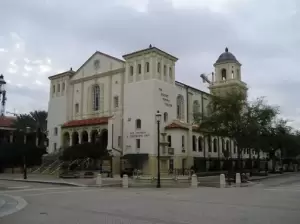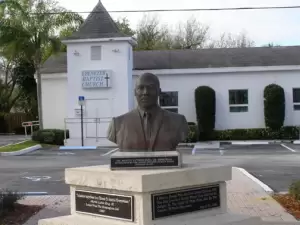Churches

Many new churches were organized in homes or new buildings to accommodate the growing population of the boom period; many established churches upgraded their structures.

In 1914, First United Methodist Church in West Palm Beach replaced their 1898 wooden chapel with a brick one costing $60,000. One of the Trustees agreed to move the old chapel, placing it on his lot and allowing the congregation to use the building until the new church was completed. The move was to be made between Sundays, but halfway down Datura Street, a cable broke, and a replacement could not be found south of Jacksonville. There was no other place to meet, so the building was blocked up in the middle of Datura, where Sunday School was held that week. In 1926 the Methodist church moved into a third building at Hibiscus and Rosemary streets. But even before it was completed, the boom turned to bust; the church struggled with a huge debt for ten years. Today the building is at the center of CityPlace as The Harriet Himmel Theater.
In Palm Beach, Saint Edward Catholic Church opened on Christmas Day 1926 at North County Road and Sunrise Avenue. The $500,000 Spanish Renaissance structure was paid for by 291 people. Bethesda-by-the-Sea Episcopal opened its third and present church, of Gothic design, in 1927 at Barton and South County Roads.
Out in the Glades, Edna Morris Harvey’s entire family was involved with their church in Pahokee in the 1920s which she recalled in an article entitled “My Life in South Florida” in Tequesta in 1983:
My mother started the First Methodist Church at our house, and most of the time we had a minister to preach for us. The piano sat in the wide doorway of the parlor that opened into a large shed, where we had benches on the dirt floor for services. [My brother] Alton played the hymns. … My dad was superintendent of the Sunday school, my mother had a class, and if for some reason one of the teachers was absent, one of us would try to teach. Even one of the boarders helped out at one time. We were scattered about the yard under the rubber trees. …. My Aunt Nettie started a Baptist Sunday school in her home about that time. On Friday nights we had singing, all of us standing around the piano, each one trying to make himself heard.
Edna Morris Harvey

Alex Hughes, the first resident of the African American neighborhood of Pearl City in Boca Raton, convinced its developer George Long to donate a lot for a church. Hughes helped build what became Macedonia African Methodist Episcopal Church in 1920. Hughes also helped acquire the land for Ebenezer Baptist Church, organized by Reverend J.H. Dolphus about 1918.

